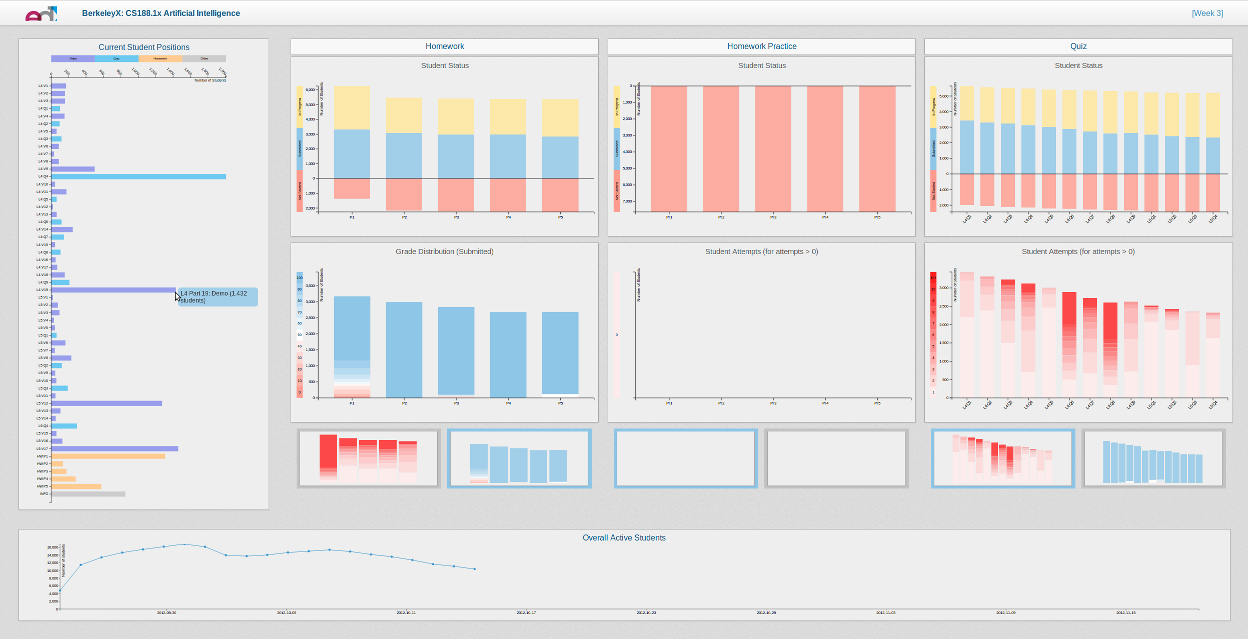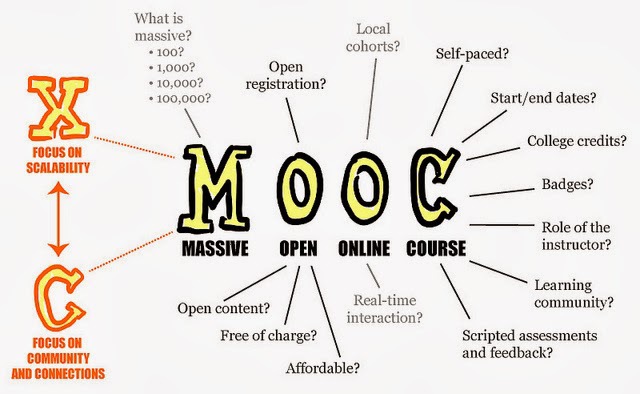Trends in online education
 Recently, the phenomenon of "torment" (MOOC), mass open online courses, has been widely heard. Platforms for them created a great many.
Recently, the phenomenon of "torment" (MOOC), mass open online courses, has been widely heard. Platforms for them created a great many.It is believed that MOOC is a new generation of books (with video, interactive tasks and a social component), which at the same time “read” tens of thousands of people. It is possible to compare “flour” with classical education for a long time and argue about their effectiveness, but it is useful to perceive them as a completely different format, obviously with its pluses and minuses.
At the same time, online education has a big conceptual difference from offline education - it is easier to measure. And everything that can be measured can be improved.
')
In this post, I’ll share personal considerations about where online education is moving on the example of MOOCs, including the reasons for attending Coursera Partners' Conference , which took place 4 weeks ago in London.
Disclaimer
If you think that I missed something important, add in the comments. If you disagree with me on anything, this is great, I will be happy to support a substantive discussion. Below I describe the trends quite widely, so if there is interest, I can deploy any of them deeper in a separate post with technical details. Separately, I note that as an instructor of a course on Coursera, I consider online education, including from teachers, not just students.
Platforms
To begin with, I will list the main international MOOC platforms (in order to broaden the horizons):
- commercial Coursera , the well-known pioneer
- Harvard and MIT non-commercial EdX , including their open source Open EdX engine, as well as the announced (but not yet launched) aggregator edX-s mooc.org from Google
- Commercial Udacity launched in competition with Coursera, but went the way of cooperation with companies instead of universities, create more applied courses
- aimed at courses with a large social component NovoEd
- Canvas Network from Instructure, which is known for the Canvas Learning Management System
- English FutureLearn from Open University, adhere to the mobile first approach
- European iversity , whose exit strategy is to sell Coursera
- and many others...
2 weeks ago there was a good comparison of Coursera, edX and NovoEd from the point of view of the teacher and the university. Coursera has more users than all the other platforms combined, which is often decisive when choosing.
Then I will talk mainly about Coursera, because they are pioneers in many areas, while the other platforms follow in their footsteps. Although each platform has its differences and nice features ...
Readers may also be interested to take a look at the Open edX Public Product Roadmap . Unfortunately, Coursera Product Roadmap is not available to the general public.
Trends
Data and Analytics

MOOC platforms collect data on students' behavior and progress, but so far these data are practically not applied or interpreted in any way. Back in 2012, Daphne Koller (co-founder of Coursera) told at TED that the data was about to make a revolution in education, “but it’s still there”. The main difficulty is that education is very different, and there is no understandable metric that needs to be optimized. At the conference, Coursera presented a new data panel for course instructors, which is much better than previously available raw data upload, but still far from ideal.
The scientific direction of Educational Data Mining previously used the results of examinations and sociological surveys of schoolchildren / students / teachers, and therefore was quite boring. Now scientists are literally buried in these "torments". Their analysis leads us to a better understanding of how people learn. Probably in the future we will observe the process of improving the quality of online education in the same way as we have observed the process of improving the quality of search on the Internet for the past 15 years. I personally believe that at some point in some areas of online education will become more effective offline education. But this is a separate topic for holivar ...
By the way, one of the main goals of the edX project, according to the creators, is to develop pedagogical research. Anonymized edX student data is distributed among all partner universities so that each university can conduct independent research on this topic. And they lead. The screenshot above is from the UC Berkeley graduate student project for edX.
Specializations
Course groups related to a common topic and dates. Something in between classic perennial education and short online courses. Increase motivation, as it becomes clear the ultimate goal of learning. Better monetized than single courses.

Blended learning
Universities begin applying their online courses to their own students in the SPOC (small private online course) format. We did it too. Usually this is combined with practical exercises and projects offline, while the video lectures and tasks with automated testing, students go online.
In addition to SPOC, the concepts blended learning, flipped classroom, hybrid learning are used, although they often denote the same thing. But formally the term SPOC refers only to the online component in blended learning. The main difference from webinars - SPOC, as well as MOOC, can be scaled (more students, restarts every semester) without additional time and effort on the part of the teacher.
Also, last year Coursera launched the Learning Hubs program, stimulating the creation of independent offline sites for student meetings and discussions of online course materials.
Application platform
Perhaps this is the most interesting point for habrasoobschestva. Since Coursera quickly increases the number of courses and partners, their development team simply does not have time to implement everything that can be useful to teachers. Examples: interactive integrated circuit designer, online code interpreter, visualization of cell processes, bioinformatics tasks. Therefore, Coursera plans to create a platform for applications in which developers can add applications, and teachers can connect them to their courses.
Coursera announced the App Platform at last year's Coursera Partners' Conference, but only in March the first information was published . From available now:
- OAuth2-based APIs - API for Coursera platform. While only viewing a profile and a list of user courses is open, other functionality will be added gradually. The same API uses Coursera in its iOS and Android mobile apps.
- Learning Tools Interoperability (LTI) Integration - a protocol for embedding external educational plug-ins into Coursera courses. We use this protocol to integrate Stepic with Coursera courses, for example in the recently launched Core Concepts in Data Analysis course. The protocol allows users to authenticate users with cursors accounts and send back their scores for completed tasks. I will tell about technical details (and rake) of integration in one of the following posts. LTI is an independent standard, therefore it is also supported by the Open edX, Canvas and other platforms.
- Catalog API - a complete catalog of courses that can be robbed and used in their aggregators / search engines for courses.
- Shibboleth / SAMLv2 - a method of authorization on Coursera on university accounts. Shibboleth is widely used in American universities, for example, at the University of California, but is little known and practically useless in Russia.
Left overs

Were not covered such important topics as:
- formal certification
- user motivation and gamification
- social component of the courses, communication with the teacher and the community, peer review
- mobile devices (example: in Africa, the Coursera mobile app is more visited, but there is no forum there)
- course localization and translation, intercultural interaction within the course
- intellectual property (who owns the course and user data, course licensing)
- privacy and data protection
- monetization and sustainable business models
Afterword
Some facts from the conference still remember twitter on the hashtag # coursera14 .
For those interested in the scientific side of the issue, 293-page works (heavy pdf) of the EMOOCs 2014 conference, held in February in Switzerland, are available. Coursera Partners' Conference materials are not currently available.
If you have read this line up, and you still like it, then after three days (1-3 May) we are in St. Petersburg with Habaton with JetBrains and Edutainme to develop tools in education , where you can be surrounded by like-minded people to do better education, Come. I'll be there all the days and I can help with advice, as well as discuss the prospects of online education for pizza.
Source: https://habr.com/ru/post/221121/
All Articles